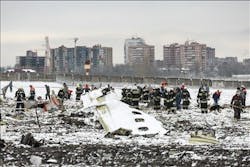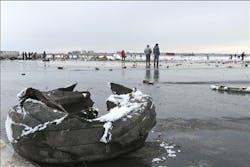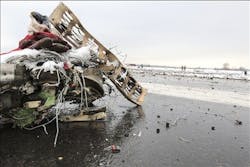Aviation experts from Russia, U.A.E., France, and U.S. investigate crash of FlyDubai flight
MOSCOW, 22 March 2016. Members of the Interstate Aviation Committee (IAC), Russia’s authority on civil aviation and airworthiness certification in Moscow, have retrieved the flight data recorder and badly damaged cockpit voice recorder from the Boeing 737-800 passenger jet operated by FlyDubai that crashed at Rostov-on-Don Airport in southern Russia on 19 March 2016.
Image courtesy http://www.donland.ru/
Difficult weather, including gusting winds described by some as “Hurricane-force winds”, are blamed for the crash, which killed all 62 people on board (55 passengers and seven crew members), of FlyDubai flight 981 (FZ981). Investigators are not ruling out the possibility of pilot error or pilot fatigue, technology malfunction or failure, or a combination of factors that include dangerous weather, related to the Boeing commercial jet built in 2011.
The FlyDubai Boeing 737 encountered bad weather, including winds in excess of 60 miles per hour, upon arrival at Rostov-on-Don Airport, Russia, after traveling from Dubai. The pilots reportedly attempted to land once, but then opted to circle the airport for two hours and wait for weather and visibility to improve before attempting a landing for a second time.
Russian Emergencies Minister Vladimir Puchkov and the area’s political officials have explained that a hurricane-force gust of wind likely struck as the pilots attempted to land the plane. Russian officials have ruled out terrorism as the cause, focusing on three possible factors: severe weather, human error, and/or technical issues.
The aircraft’s tail struck the runway before the plane went up in flames and disintegrated, according to witness accounts. Air traffic control recordings reveal seven minutes of conversation, during which the FlyDubai pilots asked about any improvement in weather conditions and visibility.
Image courtesy http://www.donland.ru/
FlyDubai is a low-cost or budget airline based in Dubai, United Arab Emirates (U.A.E.), also known as Dubai Aviation Corporation and owned by the government.
IAC professionals have extracted information from the “black boxes.” Honeywell engineers in Redmond, Washington, are credited with having designed and tested the flight data recorder with which the downed plane was equipped.
Officials from Boeing and the U.S. National Transportation Safety Board in Washington, D.C., have offered to assist the Russian IAC. “Under the direction of the U.S. National Transportation Safety Board, Boeing is launching a team and will serve as technical advisor to the investigating authority in charge, the Russian Interstate Aviation Committee (IAC),” Boeing officials said in a statement.
IAC officials reveal that the flight data recorder was left largely intact, despite the force of the violent crash, explosion, and fire. IAC workers were able to extract information from the Flash memory of the device, although they have yet to reveal the contents. The process of decoding the recovered data may take weeks or months, officials anticipate. Only the recorder’s enclosure was damaged, its underwater locator beacon torn free of it.
“The flight recorders are significantly damaged,” IAC officials explain. “The Interstate Aviation Committee specialists jointly with the specialists from the United Arab Emirates and France have started inspection, opening, and extraction of the memory modules from the protecting casing in order to continue work on recovery of the interface cables and preparation for the data downloading.
Image courtesy http://www.donland.ru/
“IAC Laboratory experts together with UAE and [Bureau d'Enquêtes et d'Analyses ] (BEA France) representatives have performed the preparation works on the extraction of the memory modules from the Flight Data Recorder (FDR) crash-protected cases, as well as the data readout,” IAC officials continue. “The preliminary analysis shows that the recorder was operational in flight, and was recording the flight data till the aircraft ground collision. The quality of recording is satisfactory. The experts start the recording data decoding and analyzing.
The Cockpit Voice Recorder (CVR) shows mechanical damages and the data cable was destroyed, IAC experts say. “X-ray radiographic examination of memory module and interface cable was performed.” Recovery of the interface cable and examination of the non-volatile memory module continue.
IAC officials are reportedly considering whether they need stricter and more comprehensive commercial airworthiness regulations and requirements.
See images of the aircraft and recovery of the flight data recorder and cockpit voice recorder:
You might also like:
Subscribe today to receive all the latest aerospace technology and engineering news, delivered directly to your e-mail inbox twice a week (Tuesdays and Thursdays). Sign upfor your free subscription to the Intelligent Inbox e-newsletter at http://www.intelligent-aerospace.com/subscribe.html.
Connect with Intelligent Aerospace on social media: Twitter (@IntelligentAero), LinkedIn,Google+, and Instagram.
Intelligent Aerospace
Global Aerospace Technology NetworkIntelligent Aerospace, the global aerospace technology network, reports on the latest tools, technologies, and trends of vital importance to aerospace professionals involved in air traffic control, airport operations, satellites and space, and commercial and military avionics on fixed-wing, rotor-wing, and unmanned aircraft throughout the world.




